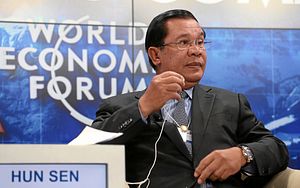On April 19, the 24th World Economic Forum on East Asia kicked off in the Indonesian capital of Jakarta. One of the main events was a conversation on “East Asia in the New Global Context,” which featured two heads of state – Cambodian prime minister Hun Sen and Indonesian president Joko “Jokowi” Widodo.
Jokowi’s keynote address stole the show as he delivered a vigorous defense of the case for reform in Indonesia, which has seen its fair share of challenges under his presidency thus far. But Hun Sen’s remarks before that were notable too.
When Hun Sen began his speech, there was little about it that suggested that a sudden tirade was on the way. He began by politely thanking Indonesia for hosting the forum and then delved into a brief and rather predictable list on what regional priorities should be, including ensuring regional cooperation and inclusive economic growth.
His third point was about regional integration, and it started with him lavishing praise on the Regional Comprehensive Economic Partnership (RCEP) – a regional free trade area including the ten ASEAN countries and those nations with existing free trade agreements (FTAs) with ASEAN – Australia, China, India, Japan, New Zealand and South Korea. He did not fail to point out that negotiations on RCEP, which would account for about half of the world’s population and 30 percent of global GDP, were initially launched in Cambodia in 2012. RCEP, he said, would provide “greater investment opportunities” and “promote more economic and trade activities.”
But he then departed from his prepared remarks for a brief tirade on the U.S.-led Trans Pacific Partnership, which groups 12 countries, four of whom are ASEAN members (Brunei, Malaysia, Singapore, and Vietnam). He stressed that TPP and RCEP should not contradict each other, but should be complementary. He then went on to blame the TPP for leaving half (or, more accurately, six out of ten) ASEAN countries outside of it.
“We should review again…why Trans-Pacific Partnership did not include ten ASEAN members,” Hun Sen said. “What is the purpose, real intention of establishing [the] Trans-Pacific Partnership…that they include half of ASEAN to be partners…and leaving half of ASEAN outside. That’s a point I would like the World Economic Forum on Asia-Pacific to provide consideration and debate,” Hun Sen said.
Hun Sen’s tirade is quite puzzling and misleading – though he is hardly the only one with such a view. Firstly, it is not very useful to compare RCEP and TPP: the former essentially is an exercise in harmonizing and integrating existing FTAs between ASEAN and its individual partners, while the latter is an attempt by the United States and others to create a new, more ambitious 21st century trade agreement with much higher standards.
Second, TPP did not intentionally exclude specific countries as is sometimes mistakenly suggested – be it other ASEAN member states or China. Rather, these countries were not able to meet the high standards of the agreement currently, and so they could not be included at this time. As U.S. officials have repeatedly said, other nations are welcome to join the TPP once they are ready to do so – which is part of Washington’s attempt to shape the rules in the region in a way that encourages a race to the top rather than to the bottom. It should be noted that other ASEAN countries, and even China, have at least studied the steps that need to be taken should they eventually decide to join TPP even if they cannot do so now.
Third and finally, the complaint that the United States is somehow ‘splitting ASEAN’ is a bit of a broken record by now and is rather outdated. While the concern initially emerged during the early stages of the TPP under the Obama administration, Washington has subsequently spent significant time trying to ensure that it economically engages the rest of ASEAN to respond to this concern. The U.S.-ASEAN Expanded Economic Engagement (E3) Initiative, rolled out in 2013, is an example of an effort in this direction. These initiatives do have their limitations, but the point here is that it is incorrect to suggest that Washington is somehow out to split ASEAN by advancing the TPP as Hun Sen did.

































